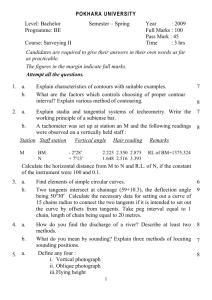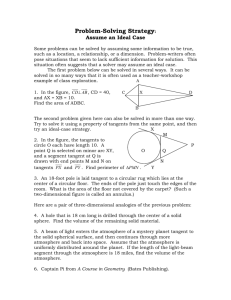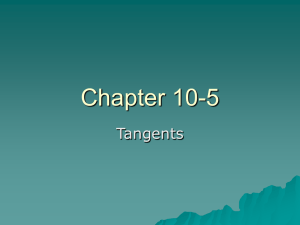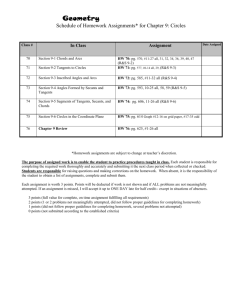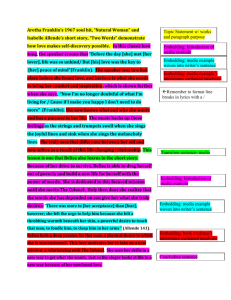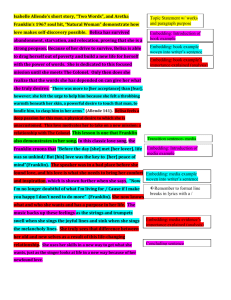New York Journal of Mathematics Totally real perturbations and Ali M. Elgindi
advertisement
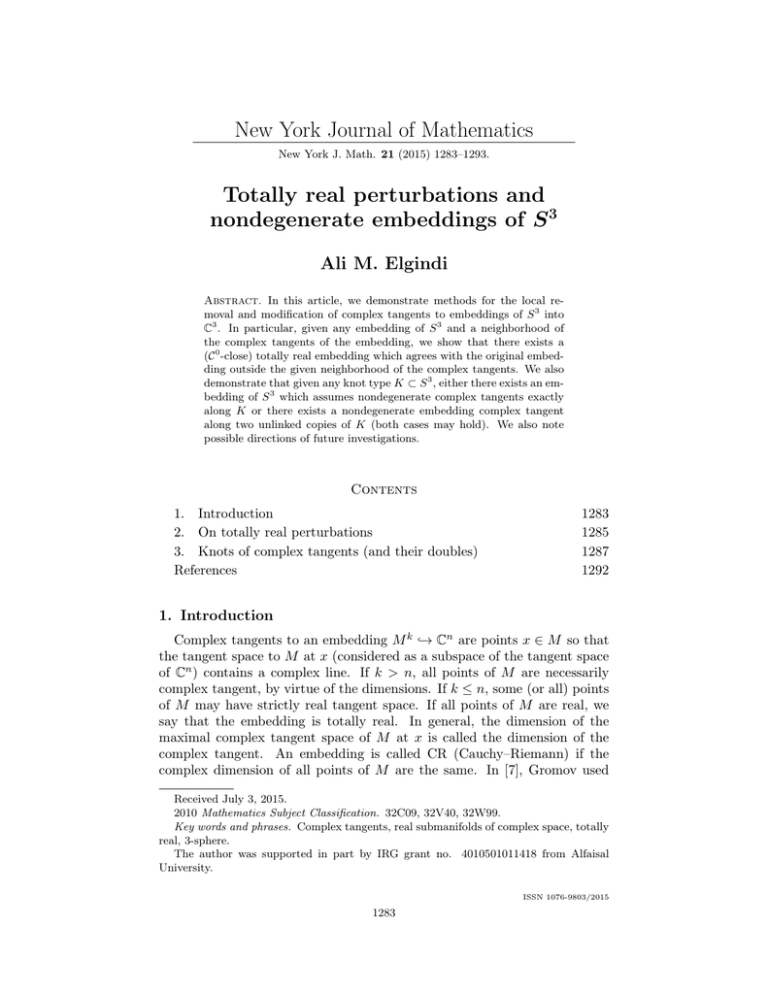
New York Journal of Mathematics
New York J. Math. 21 (2015) 1283–1293.
Totally real perturbations and
nondegenerate embeddings of S 3
Ali M. Elgindi
Abstract. In this article, we demonstrate methods for the local removal and modification of complex tangents to embeddings of S 3 into
C3 . In particular, given any embedding of S 3 and a neighborhood of
the complex tangents of the embedding, we show that there exists a
(C 0 -close) totally real embedding which agrees with the original embedding outside the given neighborhood of the complex tangents. We also
demonstrate that given any knot type K ⊂ S 3 , either there exists an embedding of S 3 which assumes nondegenerate complex tangents exactly
along K or there exists a nondegenerate embedding complex tangent
along two unlinked copies of K (both cases may hold). We also note
possible directions of future investigations.
Contents
1. Introduction
2. On totally real perturbations
3. Knots of complex tangents (and their doubles)
References
1283
1285
1287
1292
1. Introduction
Complex tangents to an embedding M k ,→ Cn are points x ∈ M so that
the tangent space to M at x (considered as a subspace of the tangent space
of Cn ) contains a complex line. If k > n, all points of M are necessarily
complex tangent, by virtue of the dimensions. If k ≤ n, some (or all) points
of M may have strictly real tangent space. If all points of M are real, we
say that the embedding is totally real. In general, the dimension of the
maximal complex tangent space of M at x is called the dimension of the
complex tangent. An embedding is called CR (Cauchy–Riemann) if the
complex dimension of all points of M are the same. In [7], Gromov used
Received July 3, 2015.
2010 Mathematics Subject Classification. 32C09, 32V40, 32W99.
Key words and phrases. Complex tangents, real submanifolds of complex space, totally
real, 3-sphere.
The author was supported in part by IRG grant no. 4010501011418 from Alfaisal
University.
ISSN 1076-9803/2015
1283
1284
ALI M. ELGINDI
the h-principle to demonstrate that the only spheres admitting totally real
embeddings S n ,→ Cn were S 1 and S 3 . In dimension 3, CR-structures are
either totally real or totally complex, two extremes which have been subject
to much study. In his paper [6], Forstneric fully resolved the totally real
problem in dimension 3; in particular he showed that every closed oriented
3-manifold can be embedded totally real into C3 .
The more general situations (proper subsets of complex tangents) have
not been as thoroughly investigated. The work of Ahern and Rudin (in
[1]) analyzed means of determining complex tangents for specific examples
and Webster (in [12]) derived topological invariants for the set of complex
tangents of embeddings of real n-manifolds into n-dimensional complex Euclidean space. In the general situation of embeddings of a real manifold into
a complex manifold of arbitrary dimensions, the work of Lia in [9] and later
of Domrin in [2] demonstrated formulas relating the characteristic classes of
the set of complex tangents with those of the embedded manifold and the
ambient complex manifold. Their results hold only under special assumptions on the dimensions of the manifolds and the structure of the complex
tangents. Furthermore, Slapar in [11] considered the situation of a generic
closed oriented manifold embedded into a complex manifold with codimension 2. In this situation, complex tangents generically are discrete (and
finite), and can be classified as either elliptic or hyperbolic by comparing
the orientation of the tangent space of the embedded manifold at the complex tangent (which is necessarily a complex vector space) with the induced
orientation of the tangent space as a complex subspace of the tangent space
of the complex ambient manifold. He demonstrated that every pair of complex tangents consisting of one elliptic point and one hyperbolic point can
be canceled out; in particular there exists an arbitrarily small isotopy of
embeddings so that the set of complex tangents of the isotoped embedding
consists exactly of the complex tangents of the original embedding minus
the given pair of complex tangents (one elliptic and one hyperbolic).
In this article, we wish to investigate the means (and flexibility) of deforming embeddings of S 3 ,→ C3 to locally remove or manipulate the set complex
tangents. In this setting, complex tangents generically arise as knots (links).
In our paper [3] we proved that for every knot type in S 3 there exists an
embedding S 3 ,→ C3 which assumes complex tangents exactly along a knot
of the prescribed type, with one point being degenerate. We further demonstrated that for every knot type, there exists an embedding whose complex
tangents form a wholly nondegenerate knot of the prescribed type union an
isolated degenerate point. Our work could be readily extended to include
all types of links.
In our paper [5], we demonstrated an obstruction to (locally) removing
an isolated complex tangent to an embedding M 3 ,→ C3 , leaving the embedding unchanged outside a small neighborhood of the degenerate point (and
without adding any new complex tangents). The obstruction is found to be
TOTALLY REAL PERTURBATIONS
1285
the homotopy class of the image of the boundary 2-sphere S of a sufficiently
small neighborhood of the degenerate point under the Gauss map in π2 (Y),
where Y is the submanifold of the real Grassmannian G 3,6 consisting of totally real 3-planes in R6 = C3 . Using the h-principle, we demonstrated that
the isolated complex tangent can be (locally) removed precisely when this
obstruction vanishes. Further, (with the vanishing of the obstruction) the
resulting embedding can be taken to be C 0 -close to the original embedding
(in the perturbed neighborhood).
We will use our findings from [5] to obtain two results for the case M = S 3 .
Our first result extends the previous work of Gromov and Forstneric (among
others) to find that given any embedding of S 3 with (not dense) complex
tangent set C ⊂ S 3 and an open ball U ⊂ S 3 containing C , there exists a
(C 0 -close) totally real embedding of S 3 that agrees with the original given
embedding outside of U .
For our second result we demonstrate that given any knot type K there
exists an embedding S 3 ,→ C3 which either assumes nondegenerate complex
tangents precisely upon K or along two identical copies of the knot K (unlinked). The complex tangents can be taken to be wholly nondegenerate in
either case (we note that both cases may hold, at least for some knot types).
This is an extension of our result in [3] where we constructed embeddings
assuming complex tangents nondegenerate along a knot of any given type,
union an isolated (degenerate) point. This result will also hold for K being
a link (type), by an extension of our work in [3].
2. On totally real perturbations
In our first consideration of interest, let S 3 ,→ C3 be an embedding of class
C k and let C ⊂ S 3 be the set of complex tangents. In the generic situation,
C will be of codimension 2 in S 3 , and as such will in the form of a knot (or
link). But here it is not necessary to assume the embedding is generic; let
us assume only that there exists an open ball U containing C (some points
are complex tangent, but are not dense). Let S be the boundary of U, in
particular S ⊂ S 3 will be a 2-sphere.
We recall from our work in [5]:
Theorem 1 ([5]). Suppose an embedding of a 3-manifold f : M ,→ C3 (of
class C k ) with Gauss map G admits an isolated complex tangent x ∈ M for
which there is a neighborhood B of x whose boundary sphere S ⊂ M satisfies:
[G(S)] = 0 ∈ π2 (Y). Then there exists a C k -embedding fe : M ,→ C3 that
can be taken to be C 0 -close to f and regularly homotopic to f so that:
(1) f = fe on M \ B.
(2) The set of complex tangents of fe equals the set of complex tangents
of f minus the point x, i.e., ℵfe = ℵf \ {x}.
1286
ALI M. ELGINDI
It is direct to see that the proof of the above theorem (in [5]) extends
analogously when we replace an isolated point by a (bounded) set, in particular we can show that we may “fill in” the neighborhood U of the set of
complex tangents C in such a totally real manner if and only if [G(S)] = 0
in Y. More precisely, with the vanishing of the obstruction, there exists an
embedding of S 3 (of class C k ) which is totally real in U and which agrees
with the original embedding in the complement of U, without adding any
new complex tangents.
By construction, the original embedding is totally real in the complement
of U. Hence, we found an embedding of S 3 which is totally real, and which
agrees with the original given embedding outside of the ball U (and C 0 -close
throughout). However, this only holds with the assumption that [G(S)] = 0
in Y, where S is the boundary of U and G is the Gauss map of the embedding. This is in fact true for all embeddings of S 3 in complex Euclidean
space.
Lemma 2. Let S 3 ,→ C3 be an embedding and let U be a 3-ball in S 3 containing all the complex tangents of the embedding, and consider its boundary
sphere S. Then the image of the Gauss map restricted to S is trivial in the
homotopy group π2 (Y).
Proof. As S ⊂ S 3 is a 2-sphere, it will necessarily cut S 3 into two parts, the
“internal” 3-ball which is the given U, and the “external” 3-ball E, which
is the interior of the complement of U in S 3 . The 2-sphere S can then be
contracted to a point in the external 3-ball E, in particular there exists a
homotopy H : S 2 × I → S 3 with Im(Ht ) ⊂ E (t > 0) so that
H|0 (S 2 ) = S
and H|1 (S 2 ) = ∗,
where ∗ is a fixed point in the 3-ball E. Consider now the homotopy:
K = G ◦ H : S 2 → Y.
Note that the image of the homotopy K is indeed contained in Y as the
image of H is contained in the external 3-ball E , which contains no complex
tangents of the embedding.
Now, K|0 (S 2 ) = G(S) and K|1 (S 2 ) = G(∗) = p ∈ Y, a point. Hence
[G(S)] = [p] = 0 in π2 (Y), which is what was claimed.
Hence, by our work in [5] and our arguments above preceding the lemma,
we have proven:
Theorem 3. Let F : S 3 ,→ C3 be a C k -embedding and let U be a 3-ball in
S 3 containing all the complex tangents of the embedding. Then there exists
a totally real embedding Fe : S 3 ,→ C3 of class C k so that Fe is C 0 -close to F
over U and Fe = F over S 3 \ U.
We note our result above generalizes the work of Forstneric and Gromov,
who asserted the existence of totally real embeddings of S 3 (and other closed
TOTALLY REAL PERTURBATIONS
1287
3-manifolds). Here, we have demonstrated that any embedding of S 3 which
is not “densely complex” may be C 0 -closely perturbed to be totally real. Our
results in fact follow from the Convex Integration techniques of Gromov.
A possible future question would be to ask if all embeddings (even those
which are complex) can be closely perturbed to be totally real. We may
even ask this question for general manifolds, although we note that our
arguments above for S 3 could not possibly generalize to other 3-manifolds,
as the 3-sphere is the only closed 3-manifold which may be split into two
balls by a 2-sphere (see Alexander’s Theorem in [8]).
3. Knots of complex tangents (and their doubles)
We now recall our result from [3], where we demonstrated that for any
given knot type (represented by K ⊂ S 3 ) and k ∈ N, there exists a graphical
embedding f : S 3 → C of class C k which assumes nondegenerate complex
tangents precisely along the knot K union an isolated (degenerate) point ∗.
While we would ultimately hope to be able to remove the degenerate
point while leaving the knot K unaffected, we are not able at this time to
fully guarantee the existence of such an embedding with complex tangents
wholly nondegenerate exactly along (a knot of type) K. Instead, we are able
to demonstrate that if there exists no such embedding of S 3 with a knot of
the prescribed type alone as complex tangent (nondegenerate), then we can
make a complex “double” of the knot, in the sense that we can construct
an embedding assuming complex tangents precisely along two identical (unlinking) copies of a knot of the given type, which are again nondegenerate.
More precisely:
Theorem 4. Consider any topological knot type in S 3 and let k ∈ N. Then
(at least) one of the following two cases holds:
(1) There exists a C k -embedding S 3 ,→ C3 assuming complex tangents
precisely along a knot of the prescribed type which is wholly nondegenerate.
(2) There exists a C k -embedding S 3 ,→ C3 assuming complex tangents
precisely along two identical copies of a knot of the prescribed type
(one in the upper hemisphere and one in the lower hemisphere),
which are hence unlinked and are wholly nondegenerate.
Proof. Consider a knot type in S 3 . We constructed a C k -function
f : C2 → C
in our article [3] whose graph (restricted to S 3 ) F : S 3 ,→ C3 assumes
complex tangents precisely along a nondegenerate knot of the prescribed
type union an isolated degenerate point. We recall that the function f is
obtained by:
f (z, w) = (g ◦ ψ)(z, w) · (1 − w)r
1288
ALI M. ELGINDI
where g : C2 → C is a (nonholomorphic) polynomial whose graph over the
e and
Heisenberg group H has complex tangents exactly along a knot K
ψ : S 3 \ {(0, 1)} → H
is the standard biholomorphism. In particular, denoting ϕ = ψ −1 , the knot
e is taken so that K = ϕ(K)
e is a knot of our desired type in S 3 , and
K
e can be assumed (without loss) to be wholly nondegenerate as
in fact K
the set of complex tangents to graph(g) in H. This follows from the fact
that the tangential CR-operator to H is onto, which allows for flexibility
to manipulate the complex tangents of embeddings H ,→ C3 directly (in
particular, via small perturbations). The function f will then have graph
F over S 3 being a C k -embedding with complex tangents along K (which
will be nondegenerate) union an isolated (necessarily degenerate) complex
tangent point at (0, 1), by the formulation of f . (We refer the reader to our
article [3] for the details of our construction.)
We may further assume without loss of generality that the knot K is
contained in the lower-half hemisphere D− = {(z, w) ∈ S 3 |Im(w) < 0},
again due to the flexibility to first manipulate the complex tangents in H
using a scaling factor. Let D+ , D− denote the upper and lower hemispheres
of S 3 , respectively.
We may now consider the Gauss map of the embedding F , which we
denote: G : S 3 → G3,6 . By construction, this embedding will be nondegenerate along the knot K and degenerate at (0, 1). Hence, the Gauss map
will intersect the subspace W ⊂ G3,6 transversely along K and intersect at
(0, 1) in a degenerate manner (see [12]).
Now, let ψe : S 3 \ {(0, −1)} → H be the “inverted” biholomorphism,
namely ψe = ψ ◦ R, where R(z, w) = (z, −w). Consider then the embedding
Fe : S 3 ,→ C given by the graph of the function:
e · (1 + w)r .
fe = (g ◦ ψ)
By an elementary computation, we find that the complex tangents to
Fe = graph(fe|S 3 )
will be precisely K ∗ ∪ {(0, −1)}, where K ∗ = {(z, −w) | (z, w) ∈ K}, a
reflection of the knot K in the upper-hemisphere of S 3 . Furthermore, the
complex tangents will be nondegenerate along K ∗ and for the same choice
of r as above in the construction of f , the embedding Fe will be of class C k .
Let > 0 be so that
K ⊂ O2 = {(z, w) ∈ S 3 | Im(w) < −2}.
Then it is clear that
K ∗ ⊂ O2 = {(z, w) ∈ S 3 | Im(w) > 2}.
Consider now the 2-sphere S which is the boundary of the 3-ball O and S which is the boundary of O .
TOTALLY REAL PERTURBATIONS
1289
Now, the embedding F : D− ,→ C3 will assume (nondegenerate) complex
tangents exactly along K, while Fe : D+ ,→ C3 will assume (nondegenerate)
e be the corresponding Gauss
complex tangents exactly along K ∗ . Let G, G
maps.
e )] in the homotopy group
We will then have two classes [G(S )], [G(S
π2 (Y) = Z2 . If either of these classes is trivial (= 0), then by our work in [5]
we may extend the corresponding embedding to the remaining hemisphere
in a totally real fashion to obtain an C k -embedding S 3 ,→ C3 assuming (nondegenerate) complex tangents exactly along the knot K (or the equivalent
K ∗ ) of the prescribed type. This is the first case of the theorem.
Let us now proceed with the second case of the theorem. Assume then
that the above assumption does not hold, namely that neither of the classes
e )] are trivial in π2 (Y) = Z2 . Then they must necessarily be
[G(S )], [G(S
equal to each other (as the homotopy group has only two elements). As
e : S → Y are homotopic. We may
such, the maps G : S → Y and G
2
2
write the homotopy as: H : S × (−, ) → S1−
2 × (−, ) → Y, with
2
S1−2 being envisioned as the 2-sphere of radius 1 − 2 . We have that:
e S .
H− = G|S , H = G|
Let D2 = {(z, w) ∈ S 3 | − 2 < Im(w) < 2}. Consider the map H :
D2 → Y defined by:
H(z, w) = G(z, w)
for −2 < Im(w) ≤ −
H(z, w) = Ht (z, w), t = Im(w),
for − < Im(w) < e w),
H(z, w) = G(z,
for ≤ Im(w) < 2.
Hence, H : D2 → Y is a continuous map from a “thickened” 2-sphere into
Y.
Let us now consider D , which we may write as: D = S 2 × I, for the
interval I = [−, ].
e S ] that
Consider the set of homotopy classes of maps [S 2 × I, Y; G|S ∪ G|
2
restrict along the boundary to the map H on S × {−, }, which is given by
e S . As this set is nonempty (we constructed above the map H), the
G|S , G|
set is in 1-1 correspondence with π3 (Y), as (S 2 × I)/∂ = S 3 (see Hatcher in
[8]).
Consider now the new embedding: E : S 3 ,→ C3 defined as follows. Recall
that F (z, w) = graph(f (z, w)) and Fe(z, w) = graph(fe(z, w)). Now
E(z, w) =
if Im(w) ≤ − 2
F (z, w)
graph( 1 (( 2 − Imw)f (z, w) + ( 2 + Imw)fe(z, w))), if − 2 < Imw < 2 .
e
F (z, w)
if Im(w) ≥ 2 .
We notice that since the embedding E corresponds with F in a neighborhood of O , the Gauss map of E, which we denote by GE , has the property
1290
ALI M. ELGINDI
that:
GE |S = G|S .
e S .
In direct analogy (in upper-hemisphere) GE |S = G|
Our goal is to demonstrate that the Gauss map GE : S 2 × I → G 3,6 is
b : S 2 × I → Y that agrees with GE on the boundary
homotopic to a map G
spheres S , S , and through such maps (agreeing on S ∪ S ). Note that
e S ] ∼
GE ∈ [S 2 × I, G 3,6 ; G|S ∪ G|
= π3 (G 3,6 )
(see Hatcher in [8]).
Now, let V3,6 be the generalized Stiefel manifold of all 3-frames in R6 and
consider the subset of totally real 3-frames V3,6 tr . We get the natural maps
sending a frame to the subspace spanned by the frames in R6 :
s : V3,6 → G 3,6
r : V3,6 tr → Y
(see Forstneric in [6] for reference for our work here and below).
Notice then the commutative diagram:
V3,6 tr −−−−→ V3,6
iV
r
s
y
y
Y
−−−−→ G 3,6
iG
where iV , iG are inclusion maps.
Applying π3 , we get the resulting commutative diagram of groups:
π3 (V3,6 tr ) −−−−→ π3 (V3,6 )
iV ∗
r
s
y∗
y∗
π3 (Y)
−−−−→ π3 (G 3,6 ).
iG∗
Now, it is known that π3 (V3,6 ) = Z2 , and from the long exact sequence of
the fiber bundle over G 3,6 , we get that the map s∗ is an isomorphism.
Also, notice that V3,6 tr ∼
= Gl3 (C) retracts to U (3), and that the space of
orthonormal 3-frames V3,6 O is a retract of V3,6 . Hence, the map
iV : V3,6 tr → V3,6
is homotopy equivalent to the map α : U (3) → V3,6 O , which is the composition of the inclusion U (3) ,→ O(6) with the quotient map O(6) → V3,6 O .
Since the first map is an isomorphism on π3 and the second is onto on π3 (see
[7]), we see that α∗ : π3 (U (3)) → π3 (V3,6 O ) is onto, and hence the inclusion
map (iV )∗ is an onto map on π3 .
TOTALLY REAL PERTURBATIONS
1291
Hence, as the above diagram in π3 commutes, s∗ ◦ iV ∗ = iG∗ ◦ r∗ is onto,
and since π3 (Y ) = Z2 = π3 (G 3,6 ) (as shown above), we have that
iG∗ : π3 (Y) → π3 (G 3,6 )
is an isomorphism.
Recall that
e S ]
π3 (G 3,6 ) ∼
= [S 2 × I, G 3,6 ; G|S ∪ G|
and
e S ].
π3 (Y) ∼
= [S 2 × I, Y; G|S ∪ G|
Now, the Gauss map GE of the embedding E is clearly an element of
e S ], and by the above equivalence and the fact that
× I, G 3,6 ; G|S ∪ G|
e S ]
b ∈ [S 2 × I, Y; G|S ∪ G|
iG is the inclusion map, there exists a map G
which is homotopic to G through maps Gt which all agree on the boundary
S 2 × {−, }.
Consider then the maps: Gt : S 3 → G 3,6 , where
[S 2
Gt |S 2 ×I = Gt , Gt |S 3 \(S 2 ×I) = GE .
b which is totally real on S 2 × I. All these
Then G0 = GE and G1 |S 2 ×I = G,
maps can be taken to be continuous. We may further extend all these maps
continuously to the “thickened” annulus D2 using the original Gauss maps
e on the lower and upper part, respectively.
G, G
In fact, by the Whitney Approximation Theorem, we may assume that all
these maps are of class C k (by taking a small homotopy). Furthermore, we
may make use the relative version of the Whitney Approximation Theorem
and assume without loss of generality that Gt agrees with the original Gauss
e on the bottom and top parts (respectively) of A2 = D2 \ D .
maps G, G
(See Lee in [10] for an exposition on the Whitney Approximation Theorem).
Hence, we have constructed a formal totally real map, which we now
b = G1 : D2 → Y of class C k that agrees with the Gauss maps G, G
e
denote G
of the original embeddings on the bottom and top parts (respectively) of the
neighborhood A2 of the boundary, and which is homotopic to GE through
maps D2 → G 3,6 , In the language of the literature, we have shown that our
constructed embedding E is formally totally real (on D2 ).
Now, applying the h-principle for extensions to this map E on D2 , we
see that since this is a formal totally real embedding which is holonomic for
3
@
3
2 ≤ |Im(w)| < 2, there exists a holonomic solution F : D2 ,→ C which
3
e
agrees with the original F for Im(w) ≥ 3
2 and with F on Im(w) ≤ − 2 .
Furthermore, F @ : D2 ,→ C3 is totally real and can be taken to be C 0 -close
to the (graphical) embedding E. (See our work in [5] and Gromov in [7] for
reference.)
1292
ALI M. ELGINDI
We may extend F @ : S 3 ,→ C3 to the entire of S 3 in the natural way,
namely:
F@ = F
for Im(w) ≤ −2
F @ = Fe
for Im(w) ≥ 2.
And as (consistently) defined above on D2 .
The fact that F @ is indeed an embedding of S 3 can be seen implicitly
as F @ can be taken to be C 0 close to E on the lower and upper caps of
S 3 (Im(w) > 2, Im(w) < −2). It then follows that there can be no selfintersections of F @ as it can be taken to be arbitrarily close to a (fixed)
graphical embedding.
Furthermore, by construction the C k -embedding F @ : S 3 ,→ C3 takes
complex tangents precisely along the unlinked knots K ∪ K ∗ , which are
both nondegenerate.
As this is based on the assumption of the second case, we have demonstrated the results of the theorem.
We note that the results of Theorem 4 may be readily extended to include
all classes of links, by an immediate generalization of our work in [3] (given
that “all links are algebraic”).
We further note that there are examples in which both cases of the Theorem will hold. In particular, in our paper [4], we demonstrated two examples
of embeddings of S 3 , one assuming complex tangents along a circle and another assuming complex tangents along two copies of a circle (unlinked). In
both examples the complex tangents were all nondegenerate.
To establish the existence of both cases, in particular for the existence
of embeddings with nondegenerate complex tangents exactly along a single
knot (of any given type), would be a worthy result. It is a problem that we
would like to see fully resolved in the future. Possible generalizations of our
results to the wider class of 3-manifolds are also of interest.
References
[1] Ahern, Patrick; Rudin, Walter. Totally Real Embeddings of S 3 in C3 . Proc.
Amer. Math. Soc. 94 (1985), no. 3, 460–462. MR0787894 (86g:32031), Zbl 0567.32006,
doi: 10.2307/2045235.
[2] Domrin, A. V. A description of characteristic classes of real submanifolds in complex
manifolds in terms of RC-singularities. Izv. Ross. Akad. Nauk Ser. Mat. 59 (1995), no.
5, 19–40. translation in Izv. Math. 59 (1995), no. 5, 899–918. MR1360632 (97c:32020),
Zbl 0877.57011, doi: 10.1070/IM1995v059n05ABEH000039.
[3] Elgindi, Ali M. On the topological structure of complex tangencies to embeddings
of S 3 into C3 . New York J. of Math. 18 (2012), 295–313. MR2928578, Zbl 1252.32041,
arXiv:1506.07992.
[4] Elgindi, Ali M. On the Bishop invariants of embeddings of S 3 into C3 . New York
J. of Math. 20 (2014), 275–292. MR3193954, Zbl 1287.32015, arXiv:1506.07988.
[5] Elgindi, Ali M. A topological obstruction to the removal of a degenerate complex tangent and some related homotopy and homology groups. Internat. J. Math.
TOTALLY REAL PERTURBATIONS
[6]
[7]
[8]
[9]
[10]
[11]
[12]
1293
26 (2015), no. 5, 1550025, 16 pp. MR3345506, Zbl 1317.32012, arXiv:1506.07985,
doi: 10.1142/S0129167X15500251.
Forstneric̆, Franc. On totally real embeddings into Cn . Exposition. Math. 4 (1986),
no. 3, 243–255. MR0880125 (88g:32016), Zbl 0597.57018.
Gromov, Mikhael. Partial differential relations. Ergebnisse der Mathematik und
ihrer Grenzgebiete, 9. Springer-Verlag, Berlin, 1986. x+363 pp. ISBN: 3-540-121773. MR0864505 (90a:58201), Zbl 0651.53001, doi: 10.1007/978-3-662-02267-2.
Hatcher, Allen. Algebraic topology. Cambridge University Press, Cambridge, 2002.
xii+544 pp. ISBN: 0-521-79160-X; 0-521-79540-0. MR1867354 (2002k:55001), Zbl
1044.55001.
Lai, Hon Fei. Characteristic classes of real manifolds immersed in complex manifolds. Trans. Amer. Math. Soc. 172 (1972), 1–33. MR0314066 (47 #2618), Zbl
0247.32005, doi: 10.2307/1996329.
Lee, John M. Introduction to smooth manifolds. Second edition. Graduate Texts in
Mathematics, 218. Springer, New York, 2013. xvi+708 pp. ISBN: 978-1-4419-9981-8.
MR2954043, Zbl 1258.53002, doi: 10.1007/978-1-4419-9982-5.
Slapar, Marko. Cancelling complex points in codimension two. Bull.
Aust. Math. Soc. 88 (2013), no. 1, 64–69. MR3096869, Zbl 1278.32025,
doi: 10.1017/S0004972712000652.
Webster, S. M. The Euler and Pontrjagin numbers of an n-manifold in Cn .
Comment. Math. Helv. 60 (1985), no. 2, 193–216. MR0800003 (86m:32034), Zbl
0566.32015.
(Ali M. Elgindi) Alfaisal University, Riyadh, Saudi Arabia
aelgindi@alfaisal.edu
This paper is available via http://nyjm.albany.edu/j/2015/21-58.html.
